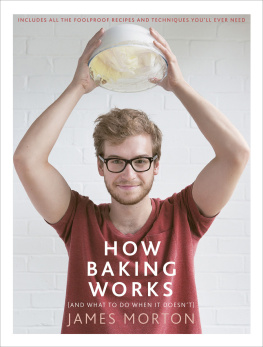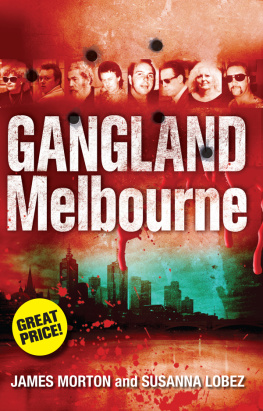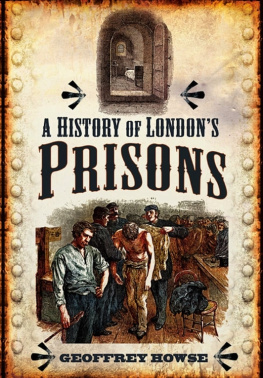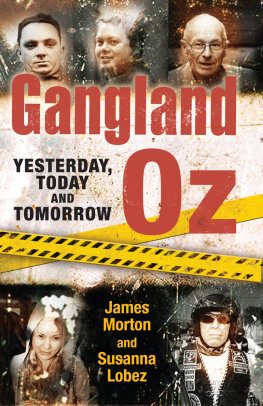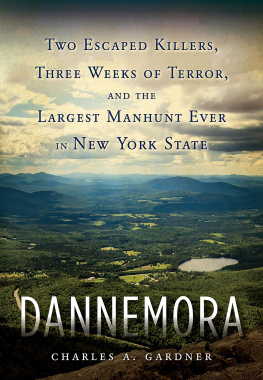GANGLAND
THE
GREAT ESCAPES
James Morton and
Susanna Lobez titles
Gangland Sydney
Gangland Melbourne
Gangland Queensland
Gangland North South & West
Gangland Australia
Gangland Robbers
Gangland Oz
Kings of Stings
Bent
Dangerous to Know
GANGLAND
THE
GREAT ESCAPES
JAMES MORTON &
SUSANNA LOBEZ

VICTORY BOOKS
An imprint of Melbourne University Publishing Limited
Level 1, 715 Swanston Street, Carlton, Victoria 3053, Australia
www.mup.com.au

First published 2018
Text James Morton and Susanna Lobez, 2018
Design and typography Melbourne University Publishing Limited, 2018
This book is copyright. Apart from any use permitted under the Copyright Act 1968 and subsequent amendments, no part may be reproduced, stored in a retrieval system or transmitted by any means or process whatsoever without the prior written permission of the publishers.
Every attempt has been made to locate the copyright holders for material quoted in this book. Any person or organisation that may have been overlooked or misattributed may contact the publisher.
Text design and typesetting by Typeskill
Cover design by Nada Backovic
Printed in Australia by McPhersons Printing Group

9780522870237 (paperback)
9780522870244 (ebook)
Contents
The third way
I do not blame a prisoner for escaping from prison, as long as he does not use violence. Although the law says it is a crime it is the duty of the prison officials to see the prisoners do not escape, and when prisoners do escape the officials are the persons who should be punished. It is only natural that a convicted person would be anxious to be free.
Mr Justice Chubb, quoted in Townsville Daily Bulletin, 24 November 1903
On 19 June 2017, with only a few weeks to run on his twelve-month sentence for a passport offence, Australian Shaun Davidson tunnelled his way out of Kerobokan prison in Bali. With him went three others, two of whom, Bulgarian ATM scammer Dimitir Nikolon Iliev and Indian drug smuggler Sayed Muhammad Said, were arrested in East Timors capital Dili three days later. Davidson, along with Malaysian drug trafficker Tee Kok King, remained at large. Almost immediately Australian social media sites were littered with messages of support and a $50,000 fund was quickly raised for him. This may be put down to a bit of jingoism with the plucky Aussie outwitting his foreign captors but possibly there is something more deep rooted at play. Because of its heritage, the nation has long had an ambivalent attitude to escapees.
There has always been a degree of sympathy and indeed admiration for prisoners who, provided they do not kill or injure anyone on the way outand sometimes even if they domake it over or under the wall. In some cases there is a curiously ambivalent view about law and order itself. At Uralla in New South Wales, where the bushranger Frederick Ward, Captain Thunderbolt, was killed by the police officer Alexander Walker, there is a plaque in commemoration of Walkers bravery but that tribute was overshadowed in 1998 when a statue of the Captain, paid for by the NSW Government, was unveiled at the spot.
Then there was Cyril Pegg, later one of Australias great criminal exports, who escaped from Darlinghurst Gaol in Sydney with an offsider in January 1911. Passengers on a tram who watched them come down the wall cheered them on their way. Over the years other members of the public have both inadvertently and intentionally hindered the authorities and helped the escapees.
Part of the misplaced admiration for Australias favourite larrikin, Joseph Leslie Squizzy Taylor, who ran Melbourne crime in the 1920snot too many criminals in modern times have had a hotel even temporarily named after themcomes from the time when he jumped bail after being found in a bonded fur warehouse, where goods on which duty has not been paid are stored. He then carried on a cat and mouse game with the police, writing self-exculpatory letters to the newspapers for almost a year until he graciously agreed to surrender.
While Les Simmonds was on the run in the spring of 1959 after killing Cecil Mills, a prison officer at Emu Plains Training Centre in Sydneys south west, public support actually seems to have grown for him. A young girl set up a fan club and the crowds who watched him driven to the magistrates court after he was captured months later cheered him rather than his captors.
The escapee doesnt even have to be Australian to be feted. Some years after the French-born coiner Pierre Douar, serving six years for forgery, escaped from Victorias Pentridge jail in 1890, Murkah reported his dash in the Worlds News as velvet-footed, and included these lines in his praise:
From cage so strong, oer wall so steep,
With fearless heart, and fearless leap.
Douar had made himself a set of keys and part of his popularity came because he neatly locked the doors behind him as he left. Unfortunately, his story did not have a happy ending.
He had only nine months to serve when he made his break, something he seems to have done because he was likely to be extradited to France to complete a sentence in New Caledonia from where he had also escaped. He was dobbed in and returned to Pentridge with an extra two years in solitary, which meant he was only allowed out of his cell for an hour out of every twenty-four and during that hour he had to wear a cowl made out of canvas pierced with holes for the eyes and the mouth. He also had to wear seven-pound (3.2-kilogram) irons. He committed suicide in the July.
There are three ways to undergo a prison sentence. The soft way, in which the prisoner obeys all the rules, working off their time as quickly as possible; the hard way, in which they cause the authorities as much aggravation as possible; and the third wayto escape.
This is an account of escapees from the time of the First Fleet to the present day. It is an account of those who have rigorously planned their escape and those who have jumped on the spur of the moment. Indeed, sometimes the kindest explanation of an escape is that the officers were simply not concentrating.
On 2 July 1982 one of the more prolific escapees of his era, Peter Patrick Clune, at the time serving nine years for armed robbery, walked out of Pentridge. He had been taking part in the theatrical groups production of One Flew Over the Cuckoos Nest when he snatched up a wig and coat and walked out with the visitors. Commenting on his escape he said, It was hardly an escape. Those clowns that run Pentridge gave me a visitors pass and I walked out with the rest of the visitors. Captured seven months later, his excuse for his escape was that a prisoner to whom he owed $2000 had said he would be killed. Why had he not gone to the authorities? He was not the type of person you would inform on, was the reply. This time he went to Jika Jikathe high-security jail within the jail at Pentridge.
It is the story of those who have escaped from prison, police stations, courts, hospitals and dentists chairs, and prison vans; of those who have swum or sailed away; of those who have killed or been killed; of those who have committed suicide by police and warders; of those who had sailed away in bath tubs, escaped in bathing costumes, and failed when disguised as a kangaroo; of those who have tried and failed and tried again until they have succeeded; of those who have gone abroad or escaped from foreign prisons and those who have stayed undetected at home; of those who have been recaptured within hours or even minutes and those who have got clean away, never to be seen again.
Next page

